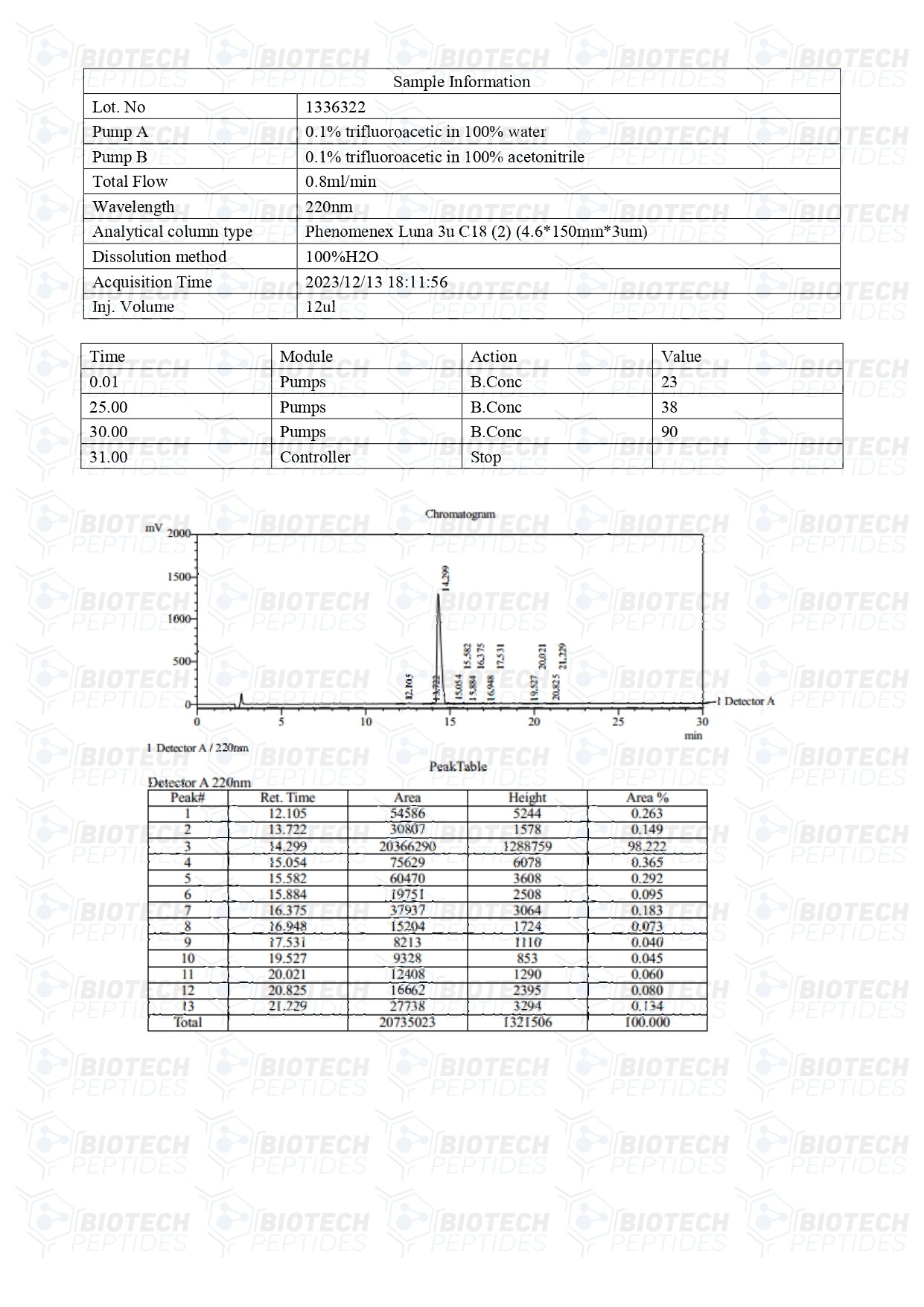No products in the cart
MOTS-c (10mg)
$99.00
MOTS-c peptides are Synthesized and Lyophilized in the USA.
Discount per Quantity
| Quantity | 5 - 9 | 10 + |
|---|---|---|
| Discount | 5% | 10% |
| Price | $94.05 | $89.10 |
FREE - 30ml bottle of bacteriostatic water
(Required for reconstitution)
FREE - USPS priority shipping
Description
MOTS-c Peptide
MOTS-c is the abbreviation for Mitochondrial-Derived Peptide (MDP). Recent research indicates that MOTS-c is a bioactive hormone closely associated with mitochondrial communication and energy regulation. Initially, researchers hypothesized that it might be most active in the mitochondria, however recent studies suggests otherwise, that MOTS-c may operate via the bloodstream, exhibiting a potentially systematic effect. It is important to note that MOTS-c is a newly identified MDP. Its primary roles are under investigation, but studies include MOTS-c peptides’ influence in cell function and longevity, muscle contractile force, metabolic function and weight regulation, and processes leading to disease states such as osteoporosis. MOTS-c is identified as a natural peptide as researchers found it in cell nuclei and are in general circulation.
Specifications
Sequence Formula: Met-Arg-Trp-Gln-Glu-Met-Gly-Tyr-Ile-Phe-Tyr-Pro-Arg-Lys-Leu-Arg
Molecular Formula: C101H152N28O22S2
Molecular Weight: 2174.64g/mol
Synonyms: 12S rRNA-c, MT-RNR1
MOTS-c Research
MOTS-c and Fat Metabolism
Oestrogen research in mice models suggests that the availability of the hormone at low levels may increase fat mass and dysfunction of normal adipose tissues. The introduction of MOTS-c in these mice models appeared to increase the prevelance of brown fat and reduce the accumulation of adipose tissue. The peptide, to an extent, may block the adipose dysfunction and inflammation that follows insulin resistance.[1]
Researchers suggest that a fraction of MOTS-c’s potential action on fat metabolism is mediated via AMPK pathway activation. The AMPK pathway is activated when cellular energy levels are low, which spurs glucose and fatty acid uptake by cells for metabolism. MOTS-c may act directly on the methionine folate cycle, enhancing AICAR levels and AMPK activation. Scientific records in mice studies indicate that in research models of obesity, MOTS-c is a potentially vital regulator of monoacylglycerol, dicarboxylate, and sphingolipid metabolism. By reducing the activity of these pathways and enhancing beta-oxidation, MOTS-c may halt fat accumulation. Most of these effects appear to be due to the action of the peptide in the nucleus.[2] The dysregulation of fat metabolism in mitochondria may possibly cause a lack of fat oxidation, resulting in increased levels of fat circulation as insulin levels increase to flush out lipids from the bloodstream. In addition, there is enhanced deposition of fat and a change in the organism’s homeostasis through increased insulin levels.[3] The scientists also note that “The implications of plasma MOTS-c for […] metabolic homeostasis deserve future examination.”
MOTS-c and Muscle Metabolism
MOTS-c, according to research in mice, may cause a change in age-related insulin-resistant muscles, with improved glucose uptake in muscle cells.[4] This potential action may be possible by enhancing skeletal muscle response to the activation of AMPK activation, which appears to sequentially increase the expression of glucose transporters. This activation does not appear to be dependent on the insulin pathway and may present another means of enhancing muscle cell glucose uptake when insulin is defective or inept. Such an outcome may enhance muscle cell growth, function, and reduce insulin resistance. The researchers conclude that “MOTS-c has implications in the regulation of obesity, diabetes, […] and longevity, representing an entirely novel mitochondrial signaling mechanism to regulate metabolism within and between cells.”
MOTS-c and Osteoporosis
MOTS-c appears to be functional in type I collagen synthesis by osteoblasts in bone. Studies closely observing osteoblast cells, suggest that MOTS-c may influence the TGF-beta/SMAD pathway that controls the function and survival of osteoblasts. Osteoblasts improve osteoblast survival, thereby bettering the synthesis of type I collagen and its strength and integrity.[5] According to scientific studies, MOTS-c may mitigate osteoporosis by possible bone marrow enhancement and stem cell differentiation via the action of the TGF-beta/SMAD pathway. According to these studies, this may result in enhanced osteogenesis, including the enhancement of osteoblast survival and stem cell development.[6]
MOTS-c and Insulin Sensitivity
In cases of insulin resistance, MOTS-c posits to be vital in the pathogenesis of insulin insensitivity, but may not be in sustaining the condition. Scientists suggest that the peptide may be vital in the examination of pre-diabetic research models—and early warning of potential insulin insensitivity could be a consequence of the changes in MOTS-c levels. The exposure to MOTS-c in this manner may avert insulin resistance and the onset of diabetes as hypothesized in animal research models. More research must be carried out to discern the full action of MOTS-c on insulin regulation.
MOTS-c and Heart Function
A higher risk of endothelial cell dysfunction was reported in research models of coronary angiography. Endothelial cells line the inner wall of blood vessels and are considered vital in regulating blood clotting, blood pressure, and plaque function. Scientific studies report that MOTS-c does not appear to alter the responsiveness of blood vessels directly; rather it may possibly sharpen endothelial cells to the signaling effects of other molecules like acetylcholine.[7] Introducing the peptide in mice appeared to improve endothelial, microvascular, and epicardial blood vessel functions. Research records indicate that MDPs alongside the MOTS-c, may function to stave off inflammation and stress in cardiomyocytes. It is assumed that a down-regulation of MDP may cause a risk of the development of cardiovascular diseases. MOTS-c may be vital in reperfusion injury and endothelial functions.
MOTS-c and Cell Lifespan
A change in glutamate residue for lysine at the 14th position of the protein appears to be a consequence of changes in the gene MOTS-c. Though, it has not yet been determined how this may influence the functional properties of MOTS-c. Nonetheless, a change in both structure and function of the MOTS-c gene has been hypothesized, which may result in phenomenal cell longevity. In research conducted by Dr. Changhan David Lee—a researcher at the School of Gerontology at USC—Mitochondrial biology asserts the need to prolong cell lifespan and healthspan.[8] Dietary constraints posit the only means of altering mitochondrial function and longevity. This peptide may make it possible to apply directly to mitochondrial function.
Disclaimer: The products mentioned are not intended for human or animal consumption. Research chemicals are intended solely for laboratory experimentation and/or in-vitro testing. Bodily introduction of any sort is strictly prohibited by law. All purchases are limited to licensed researchers and/or qualified professionals. All information shared in this article is for educational purposes only.
References
- Lu H, Wei M, Zhai Y, Li Q, Ye Z, Wang L, Luo W, Chen J, Lu Z. MOTS-c peptide regulates adipose homeostasis to prevent ovariectomy-induced metabolic dysfunction. J Mol Med (Berl). 2019 Apr;97(4):473-485. doi: 10.1007/s00109-018-01738-w. Epub 2019 Feb 6. PMID: 30725119.
- Kim KH, Son JM, Benayoun BA, Lee C. The Mitochondrial-Encoded Peptide MOTS-c Translocates to the Nucleus to Regulate Nuclear Gene Expression in Response to Metabolic Stress. Cell Metab. 2018 Sep 4;28(3):516-524.e7. doi: 10.1016/j.cmet.2018.06.008. Epub 2018 Jul 5. PMID: 29983246; PMCID: PMC6185997.
- Cataldo LR, Fernández-Verdejo R, Santos JL, Galgani JE. Plasma MOTS-c levels are associated with insulin sensitivity in lean but not in obese individuals. J Investig Med. 2018 Aug;66(6):1019-1022. doi: 10.1136/jim-2017-000681. Epub 2018 Mar 27. PMID: 29593067.
- Lee C, Kim KH, Cohen P. MOTS-c: A novel mitochondrial-derived peptide regulating muscle and fat metabolism. Free Radic Biol Med. 2016 Nov;100:182-187. doi: 10.1016/j.freeradbiomed.2016.05.015. Epub 2016 May 20. PMID: 27216708; PMCID: PMC5116416.
- Che N, Qiu W, Wang JK, Sun XX, Xu LX, Liu R, Gu L. MOTS-c improves osteoporosis by promoting the synthesis of type I collagen in osteoblasts via TGF-β/SMAD signaling pathway. Eur Rev Med Pharmacol Sci. 2019 Apr;23(8):3183-3189. doi: 10.26355/eurrev_201904_17676. PMID: 31081069.
- Hu BT, Chen WZ. MOTS-c improves osteoporosis by promoting osteogenic differentiation of bone marrow mesenchymal stem cells via TGF-β/Smad pathway. Eur Rev Med Pharmacol Sci. 2018 Nov;22(21):7156-7163. doi: 10.26355/eurrev_201811_16247. PMID: 30468456.
- Qin Q, Delrio S, Wan J, Jay Widmer R, Cohen P, Lerman LO, Lerman A. Downregulation of circulating MOTS-c levels in patients with coronary endothelial dysfunction. Int J Cardiol. 2018 Mar 1;254:23-27. doi: 10.1016/j.ijcard.2017.12.001. Epub 2017 Dec 6. PMID: 29242099.
- Fuku N, Pareja-Galeano H, Zempo H, Alis R, Arai Y, Lucia A, Hirose N. The mitochondrial-derived peptide MOTS-c: a player in exceptional longevity? Aging Cell. 2015 Dec;14(6):921-3. doi: 10.1111/acel.12389. Epub 2015 Aug 20. PMID: 26289118; PMCID: PMC4693465.
Dr. Usman (BSc, MBBS, MaRCP) completed his studies in medicine at the Royal College of Physicians, London. He is an avid researcher with more than 30 publications in internationally recognized peer-reviewed journals. Dr. Usman has worked as a researcher and a medical consultant for reputable pharmaceutical companies such as Johnson & Johnson and Sanofi.
Additional information
| Brand | Biotech Peptides |
|---|
You must be logged in to post a review.








Reviews
There are no reviews yet.